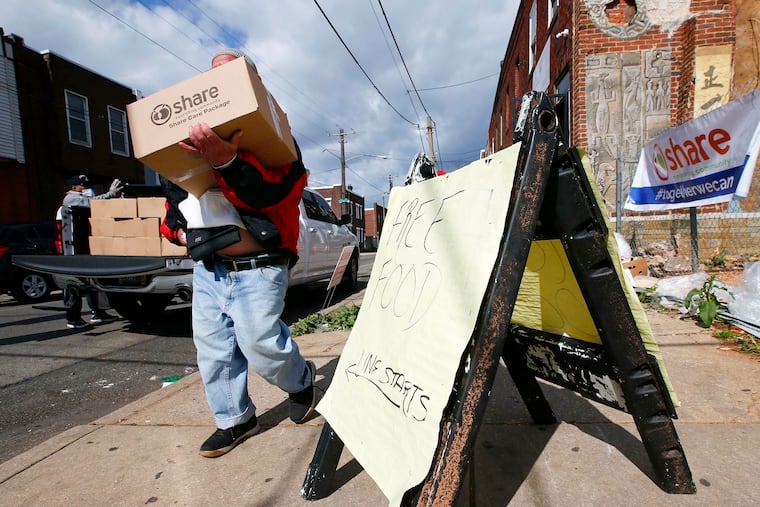‘Catastrophe’ at Philly food bank short on funding and food because of administrative change
The change has lead to drastic cuts for Share Food Program, making it harder for them to serve their partner pantries.

The state’s Department of Agriculture has implemented a small procedural change in a little known federal government food program that will cost Share Food Program, a community based nonprofit food bank, big bucks — an estimated $300,000 this year alone.
After more than 30 years of the Share Food Program managing The Emergency Food Program (TEFAP) without a problem, the city’s Office of Homeless Services (OHS) was recently given the responsibility of TEFAP oversight.
TEFAP provides surplus food from the U.S. Department of Agriculture to states, which then send it to local organizations, like a food bank, to redistribute to grassroots providers. The food is allocated in Pennsylvania based on each county’s poverty and unemployment rates, and the number of food insecure individuals being served.
The program also provides administrative fees to each county for the support, storage, transportation, and distribution of the food.
Since the inception of TEFAP until last October, Philadelphia opted to have the Share Food Program directly manage the program, distribute the food and receive the fees.
While it is unclear who first requested the administrative change, both the city and state agree it wasn’t a matter of malfeasance or poor performance on Share’s part. Rather, it was a move to align the city with the other 66 counties, where a county agency is the state’s point of contact.
However, one of the first changes OHS Executive Director Liz Hersh made after OHS started administering the program was to name two lead agencies, Philabundance and Share Food Program, instead of one. No other county in the state has more than one lead agency.
The move effectively splits the estimated $600,000 in administrative fees, and the food received, between the two organizations.
What was a blessing for Philabundance was a hard blow for Share and its pantry partners.
Hersh said that after conducting an eight-month feasibility study, she is convinced that the change will increase food equity — because Share and Philabundance don’t serve the same pantries. This move will allow Philabundance-related pantry partners greater access to TEFAP food products.
Food banks operate either independently, like Share Food Program, or, like Philabundance, as a part of the Feeding America Network — the country’s largest nonprofit, according to the Forbes’ annual top charities list. It receives over $4 billion in donations, including corporate food donations, to service 200 food banks.
“Their idea of equitable is completely baffling. Was it equity to take away from an organization and give to a multimillion-dollar corporation? That’s baffling and I can’t understand it,” Share’s Executive Director George Matysik said.
Matysik said the state’s move has left his agency with less food and its budget with less money.
“Since 2022, there has been a decline in the types and amount of [government] food we are getting. Not only are you carving a pie, but you are also carving a smaller piece than where we were last year,” Matysik said.
“I would call it a catastrophe,” said J. Jondhi Harrell, founder and executive director of the TCRC Community Healing Center, which provides an outdoor weekly food giveaway at sites in West and North Philadelphia. Harrell’s program, which serves about 16,000 people a month, is Share Food Program’s largest food recipient.
“We went from 1,200 cases of food per week — 600 to West Philadelphia and 600 to North Philadelphia — to half of that.”
“I am on my way to Salem, N.J., to pick up food to supplement my events even as I talk to you. We went from 1,200 cases of food per week — 600 to West Philadelphia and 600 to North Philadelphia — to half of that,” complained Harrell, who said he first felt the impact of the changes in December.
“Increasing the amount of food to Philadelphia vendors is not a bad idea,” Harrell admitted, but added, “No one came out and talked to us. How do they determine who gets what?”
For Philabundance, TEFAP represents a new fee and food source at a time when consumer need has escalated. “We have doubled the amount of food we supply annually from 25 million to 50 million pounds,” said Loree D. Jones Brown, chief executive director of Philabundance.
However, she said current supply chain, transportation and inflation problems make it harder to source enough food to handle a growing need. And at the end of February, the Supplemental Nutrition Assistance Program (SNAP) Emergency Allotments will end.
“It’s the perfect storm,” Jones Brown said.
Tinamarie Russell of the Philadelphia Association of Former Gang Members and Friends, said Philabundance always had a larger selection of food but Share could provide the volume necessary to serve a city where one out of every 10ten households is food insecure.
“The cuts are very drastic. There is less to give out and less variety,” Russell said.
“People have to go out to other places to acquire food and for people who are handicapped, seniors, or using transportation — it’s difficult.”
The Philadelphia Inquirer is one of more than 20 news organizations producing Broke in Philly, a collaborative reporting project on solutions to poverty and the city’s push toward economic justice. See all of our reporting at brokeinphilly.org.